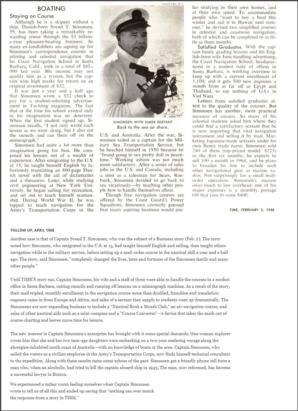
NavList:
A Community Devoted to the Preservation and Practice of Celestial Navigation and Other Methods of Traditional Wayfinding
From: Frank Reed
Date: 2024 Jan 11, 09:41 -0800
You wrote:
"I may just try the old Heath Bell frame with its lower power inverting scopes"
But wait, do you still think you need an inverting scope for some reason? Why? Let me be very clear: You do not need an inverting scope. You do not need a 12-power scope for any practical purpose.
The presence of that inverting scope in the Simex kit that you have is a legacy of its origin as a Tamaya sextant. We know that the Simex is a Tamaya-like, ordered originally by Svend Simonsen c.1965. Tamaya specifically (and perhaps other Japanese sextant manufacturers) continued to include these scopes in their standard sextant kits decades after they had disappeared elsewhere. The scopes are pointless. As far as I can determine, their presence reflects one of the most universal properties of celestial navigation practice worldwide -- a bllind and brainless adherence to tradition. Don't fall for it.
I contend that these oddball scopes continued for decades because of tradition. But then what was the original reason for their existence that later spawned this tradition-observant devotional behavior? Why were these high-power inverting scopes originally included in sextant kits? That we know, right? Scopes like these first appeared over 200 years ago. They were lunars scopes. You can find these old scopes included as optional components for sextants in the lunars period, and they are essentially identical to what we see in the Simex case: high-magnification, long-tube, small-aperture inverting scopes with crosshairs in the focal plane. It's a distinct set of features that continued, thanks to tradition, long after lunars had ceased to be practical. If you enjoy experimenting with lunars, they can still be valuable for that purpose today. But they have no significant function in modern celestial navigation, and they are certainly not actively required for any function of modern celestial.
And why Japanese sextants? Here I offer a simple speculation...
Both Japan and Germany share something in common in naval history, and I don't mean to suggest anything to do with their participation on the evil side in the "recent unpleasantness" (the recent unpleasantness... eighty years ago). Both countries arrived on the world stage as would-be imperial powers rather late: in the second half of the nineteenth century. And both countries set about building modern maritime practice, not from established lore and tradition, but from analyses of maritime science.
Picture Japan at the beginning of 1853. There is no navy, no ocean-going maritime fleet, and there are only a handful of people with maritime skills or any experience using sextants. Blown away by the "diplomacy" of Matthew Perry (a "local boy" *) and his armada of US Navy ships, the government of Japan submits to a revolution and begins a process of deliberate, breakneck modernization that includes requirements for all the tools of the sea-going navigation trade. It is a national project. They succeed magnificently, and in half a century their navy dominates the western Pacific and soon decimates the navy of the Tsar of Russia.
The Japanese were deliberate about this process of modernization, and they did not simply borrow "hoary old practice" along with the technology. They also did not acquire whatever was merely new, novelty over practicality. They chose what they would use. They decided pro-actively what would become part of their suite of maritime technologies. It is quite possible that there was a specific meeting, a gathering of newly-minted navigation experts, probably advised by John Nakahama Manjiro, who assembled and wrote up requirements for Japanese sextants (and probably there are records of this that have probably not been fully examined), and these requirements at least strongly advised that these peculiar 12-power inverting sextant scopes should be available to navigators --in case they were required for lunars, maybe, because on purely theoreticl grounds, lunars still seemed like a good idea. After that, tradition won the day.
Frank Reed
Clockwork Mapping / ReedNavigation.com
Conanicut Island USA
* Matthew Perry who led the naval "diplomatic" mission to Edo (Tokyo) was a "local boy"... born about ten nautical miles from where I am typing this message. His older brother, Oliver Hazard Perry, became a naval hero decades earlier. Oliver H. P. also got a sail-training square-rigged ship here in RI named after him in 2015. It's a lovely steel-hulled monster, a white elephant --about as useful as a 12-power sextant scope.







